Twm

twm desktop
|
|
| Original author(s) | Tom LaStrange |
|---|---|
| Initial release | 1987 |
| Development status | Active |
| Written in | C |
| Operating system | Unix-like |
| Type | Window manager |
| License | MIT License |
twm (Tab Window Manager) is a window manager for the X Window System. Started in 1987 by Tom LaStrange, it has been the standard window manager for the X Window System since version X11R4. The name originally stood for Tom's Window Manager, but the software was renamed Tab Window Manager by the X Consortium when they adopted it in 1989. twm is a re-parenting window manager that provides title bars, shaped windows and icon management. It is highly configurable and extensible.
twm was a breakthrough achievement in its time, but it has been largely superseded by other window managers which, unlike twm, use a widget toolkit rather than writing directly against Xlib.
Various other window managers—such as vtwm, tvtwm, CTWM, and FVWM—were built on twm's source code.
twm is still standard with X.Org Server, and is available as part of many X implementations.
twm's interface is different from modern common X window managers and desktop environments many of which tend to work similarly to the Apple Macintosh or Microsoft Windows. New users often find twm difficult without reading the manual page.
In the default configuration of twm, the title bar has two buttons:
There is no title bar button to close a window. A left click on the desktop brings up a menu, which includes an option to delete (close) a window. Window close functionality for the titlebar can be configured in the .twmrc file:
A left click on the title bar brings the window to the top of the window stack; a middle click moves the window; a right click sends the window to the bottom of the window stack.
Window focus follows the mouse pointer (point-to-focus), rather than being on whichever window was clicked last (click-to-focus).
...
Wikipedia
